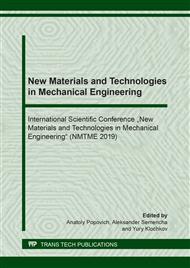p.362
p.373
p.381
p.389
p.396
p.404
p.410
p.418
p.425
Measurement of Thermal Cycle at Multi-Pass Layer Build-Up with Different Travel Path Strategies during DLMD Process
Abstract:
The shape of the parts, created by the technology of direct laser metal deposition (DLMD), is influenced by various parameters, for example, the power and diameter of the laser source spot. The contribution of energy from the laser affects the temperature distribution in the formed layers. The changing temperature in the working area entails a change in the geometry of the layers and affects the stability of the process. In this paper, experiments on the measurement of temperature cycles in the DLMD process with different directions of the filling track are carried out. An infrared camera was used to measure thermal cycles. The correspondence table between the intensity of thermal radiation of the material and the absolute temperature was developed. The experiments are carried out with the filler material 316L. The effect of the maximum temperature on the layer height is shown, and thermal cycles in the formation of layers for different filling strategies are presented.
Info:
Periodical:
Pages:
396-403
Citation:
Online since:
September 2019
Authors:
Price:
Сopyright:
© 2019 Trans Tech Publications Ltd. All Rights Reserved
Share:
Citation:


